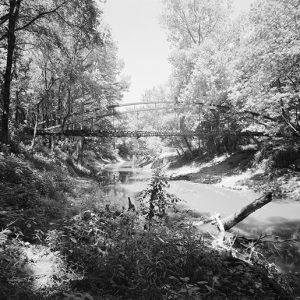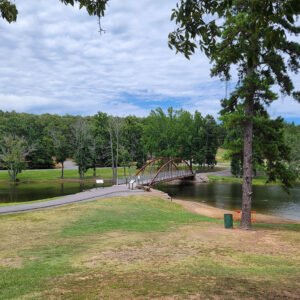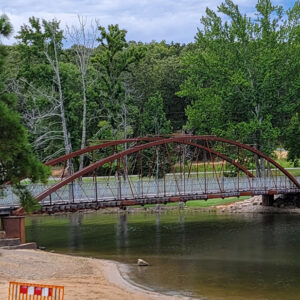calsfoundation@cals.org
Springfield–Des Arc Bridge
aka: Springfield Cadron Bridge
aka: Springfield Bridge
The Springfield Bridge is the oldest bridge in Arkansas, although it has been moved from its original location. It was erected in 1874 across the North Cadron Creek three miles east of Springfield (Conway County) on the Springfield–Des Arc Road. This early thoroughfare connected Des Arc (Prairie County), a thriving port for steamboat traffic on the White River, with Springfield, the county seat of Conway County from 1850 to 1873.
Before the bridge was built, C. A. Simmons operated a ferry at the river crossing, charging five cents for a pedestrian, fifteen cents for a person on horseback, or seventy-five cents for a two-horse spring carriage.
On November 8, 1871, Conway County awarded a contract to the King Bridge Company of Cleveland, Ohio, for the construction of a wrought-iron bridge. The company, which became the largest highway bridgeworks in the country, built this bridge at its ironworks in Iola, Kansas.
In 1872, the bridge was shipped to Lewisburg (Conway County), near what is today Morrilton (Conway County). The erection of the bridge was delayed by political factors in 1873 when the Arkansas General Assembly relocated the Conway County seat from Springfield to Lewisburg and created Faulkner County from the part of Conway County east of the Cadron Creek. Conway County filed suit against Faulkner County for half of the cost of the bridge, given that the bridge would span both counties. The bridge was finally put in place in July 1874.
The bridge’s “bowstring arch truss” design followed a patent by the King Bridge Company granted in 1867, and the bridge is one of the oldest surviving examples of its type in the United States. It measures 146′ in length, 14′ 7″ from the floor to the highest point, and 19′ 4″ wide with a roadway of 11′ 6″. The bridge originally sat on locally quarried stone abutments measuring four feet thick and sixteen wide.
The bridge has been subject to the normal pressures of time and nature. Floods have periodically ravaged the bridge. On May 25, 1882, the Arkansas Gazette reported flooding on Cadron Creek: “At the iron bridge it was more than a mile wide, and deep enough to sweep over the floor of the bridge.” During the Flood of 1927, wire cables were attached to the bridge and tied to nearby large trees to keep the bridge from washing away. In December 1982, the bridge was damaged when it was again submerged by floodwaters.
Guy W. Murphy and the Faulkner County Historical Society were instrumental in getting the Springfield Bridge placed on the National Register of Historic Places in 1988. The bridge was replaced in 1991 by a modern concrete structure approximately 150 feet to the north. After it was taken out of service, the bridge deteriorated due to vandalism and erosion. In 2016 and 2017, through the cooperation of Faulkner County, the City of Conway, and the Faulkner County Historical Society, the bridge was restored and moved to span a cove in Lake Beaverfork Park, just north of Conway (Faulkner County).
For additional information:
Fellone, Frank. “Spanning History.” Arkansas Democrat-Gazette, June 12, 2016, pp. 1E, 6E.
“Historic American Engineering Record, Springfield-Des Arc Bridge, HAER No. AR-32.” Online at https://www.arkansashighways.com/historic_bridge/HAER%20Documents/AR-32%20Springfield-DesArc%20Bridge%20%2813045%29.pdf (accessed July 26, 2017).
Murphy, Guy. “Springfield-Des Arc Bridge.” Faulkner Facts and Fiddlings 29 (Fall/Winter 1987): 1–12. [This issue is misidentified on the cover as 30 (Fall/Winter 1988).]
Petrucelli, Fred. “A Dedication: The Springfield-Des Arc Bridge.” Faulkner Facts and Fiddlings 34 (Fall/Winter 1992): 18–23.
Schnedler, Jack. “State’s Oldest Surviving Bridge Now Part of Park.” Arkansas Democrat-Gazette, August 11, 2020, p. 2E.
“Springfield Bridge.” National Register of Historic Places registration form. On file at Arkansas Historic Preservation Program, Little Rock, Arkansas. Online at http://www.arkansaspreservation.com/National-Register-Listings/PDF/FA0852.nr.pdf (accessed July 26, 2017).
Kenneth C. Barnes
University of Central Arkansas
 Historic Preservation
Historic Preservation Post-Reconstruction through the Gilded Age, 1875 through 1900
Post-Reconstruction through the Gilded Age, 1875 through 1900 Springfield-Des Arc Bridge
Springfield-Des Arc Bridge  Springfield-Des Arc Bridge
Springfield-Des Arc Bridge  Springfield-Des Arc Bridge
Springfield-Des Arc Bridge  Springfield-Des Arc Bridge
Springfield-Des Arc Bridge 




Comments
No comments on this entry yet.